Blockchain bridges are changing the web3 space for the better, allowing independent chains to work together. This is a huge milestone toward building a seamless, interoperable, and efficient blockchain space. In this article, you’ll learn about the Arbitrum bridge and how you can use it to move Ethereum-based coins and tokens.
Choose your wallet to start using Arbitrum Bridge
Hundreds of tokens & dapps supported
Non-custodial web3 wallet
No seed phrase vulnerability (WalletConnect support)
Self-custodial mobile wallet
Wallet created specially for Ethereum blockchain
Non-custodial wallet
What are blockchain bridges?

Blockchain bridges are tools that connect one blockchain to another, enabling users to transfer digital assets. They solve the lack of interoperability between blockchains.
Typically, blockchains work excellently as single entities but do not work well together. In fact, they are usually not interoperable. This is because each blockchain is different and abides by separate rules. Bridges are the solution to this obstacle.
As part of their role, bridges create synthetic derivatives that represent digital currencies from other chains. For instance, sending a Solana token to Ethereum through a bridge will produce a “wrapped” version of the token. This simply means that the bridge will convert the digital asset to an ERC-20 token, a “format” compatible with the Ethereum blockchain. Hence, in the Ethereum wallet, you’ll receive a bridged version of the Solana token that has been converted to an ERC-20 token.
SponsoredBridges make life easy for active crypto users by giving them access to multiple blockchains. Also, they allow users to possibly avoid the high transaction costs of blockchains like Ethereum by bridging to cheaper layer-2 (L2) chains like Arbitrum. However, not all blockchain bridges are built equally. Some are uni-directional, meaning they can only transfer tokens one way. Others are bidirectional, which means they can transfer tokens from Solana to Ethereum and vice versa. Most bridges, including Arbitrum, are bidirectional.
Moreover, blockchain bridges can be custodial or non-custodial. Centralized entities control the tokens used to create bridged assets in custodial bridges. On the other hand, tokens that produce bridged assets are held by decentralized protocols in non-custodial bridges.
Besides tokens, blockchain bridges can also transfer data, feedback, instructions, and smart contracts between blockchains. Blockchain bridges are also called cross-chain bridges.
What is the Arbitrum bridge?

The Arbitrum bridge launched as an Ethereum L2 scaling solution, which means it seeks to be faster and cheaper than the Ethereum mainchain.
On Arbitrum, users can interact with decentralized applications (DApps) and smart contracts the same way they can on Ethereum. Arbitrum is built on top of the Ethereum blockchain and uses its security. Its goal as a scaling solution is to solve the high cost of transactions on Ethereum and boost transaction speeds. Arbitrum uses optimistic rollups to improve Ethereum’s throughput. Optimistic rollups are L2 scaling technology that uses off-chain computation to record transactions.
Bridging from Ethereum to Arbitrum simply means escrowing a given amount of the token in an L1 bridge contract and creating a similar amount at the paired L2 token contract. In other words, smart contracts are used in the bridging process. A smart contract is a piece of code living on the blockchain that executes when predetermined conditions are met.
Offchain Labs, the company behind Arbitrum, built a protocol with the ability to pass messages and assets between it and the Ethereum blockchain. Therefore, users can move all Ethereum-compatible tokens, such as ERC-20, ERC-721, and ether, from Ethereum to the Arbitrum chain and potentially enjoy faster and cheaper transactions. They can also move their tokens back to Ethereum through a withdraw function.
Offchain Labs has developed two Arbitrum chains running in parallel on the Ethereum blockchain. They are Arbitrum One, which is the roll-up chain, and Arbitrum Nova, which uses the AnyTrust protocol. AnyTrust is an Arbitrum protocol that’s cheaper than Arbitrum One but less trustless. Rather than posting data to the Ethereum mainnet (layer 1) like Arbitrum One, AnyTrust manages data off-chain, allowing it to offer lower fees. Users can select either one of these chains when bridging to and from Ethereum, depending on the transaction costs they wish to pay.
Both Arbitrum One and Arbitrum Nova give users access to a wide range of Ethereum DApps. Go to the Arbitrum One Portal and Arbitrum Nova Portal to view the list of decentralized applications you can access.
How to use Arbitrum bridge?
You’ll need a MetaMask wallet or a wallet that supports WalletConnect, with ether coins to use the Arbitrum bridge. Ether is important because it pays for the gas fees.
Here’s how you can use this cross-chain bridge!
How to connect Arbitrum to MetaMask
Assuming you already have a MetaMask wallet, you can easily connect Arbitrum to it. In this example, we will use the MetaMask browser extension. This extension is available for Google Chrome, Firefox, Brave, Edge, and Opera.
- To begin, visit the Arbitrum bridge website.

- Connect your MetaMask wallet. Ensure that the selected network on the wallet is Ethereum Mainnet. Also, top up your wallet with ETH before connecting Arbitrum to MetaMask. You can purchase ETH from a crypto exchange and transfer it to your MetaMask.

- Type in your MetaMask password.
- Click “Next.”

- Next, click “Connect.” You can now access your wallet on the Arbitrum bridge website.

Bridge crypto from Ethereum to Arbitrum
Now that you have connected Arbitrum to MetaMask, you can easily bridge crypto from Ethereum to Arbitrum One or Nova. Follow these steps.
- First, add the Arbitrum One network to MetaMask. To do this, open your wallet and click the drop-down menu at the top. Next to Arbitrum One, click “Add.”
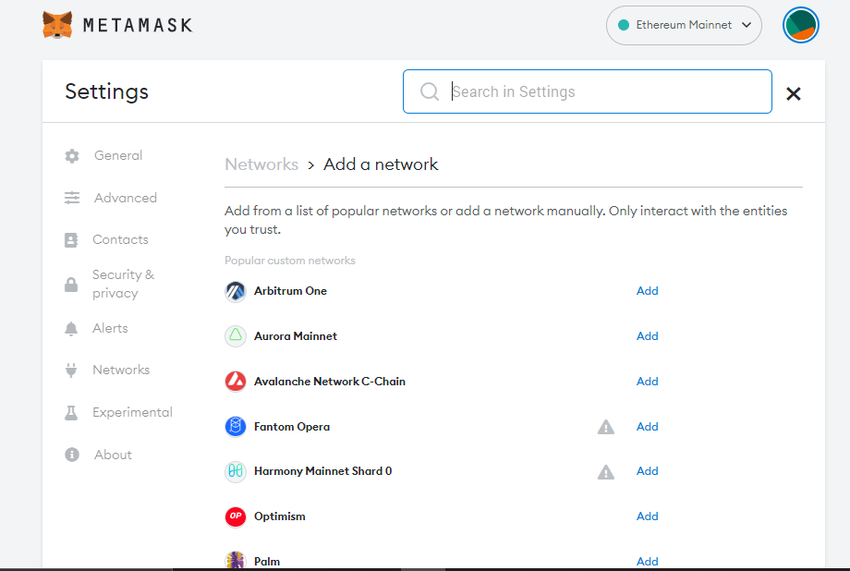
- Approve the action.
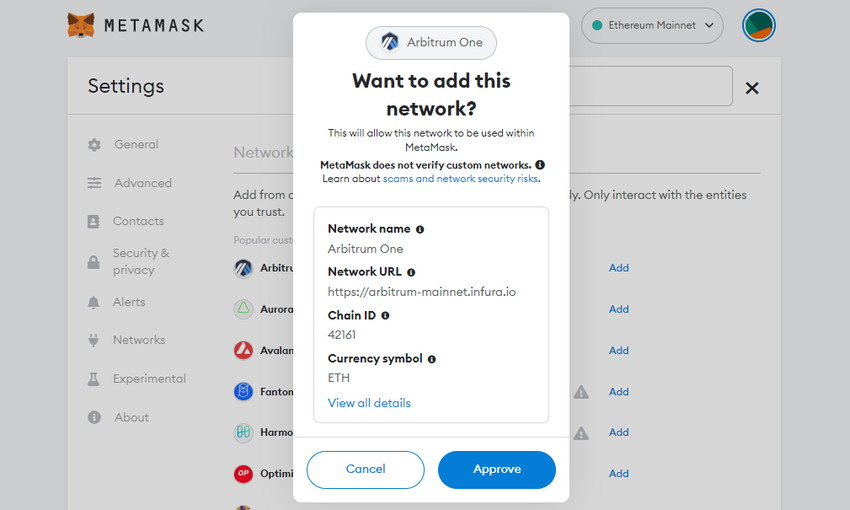
- Switch the network to Arbitrum One.

- If you want to use Arbitrum Nova, you’ll notice that it’s not on the list of networks. So, to add it to MetaMask, open the ChainList website on your browser. Search for Arbitrum Nova in the search field. ChainList is a website that lists Ethereum Virtual Machine (EVM) networks and helps users add them to their MetaMask wallets.
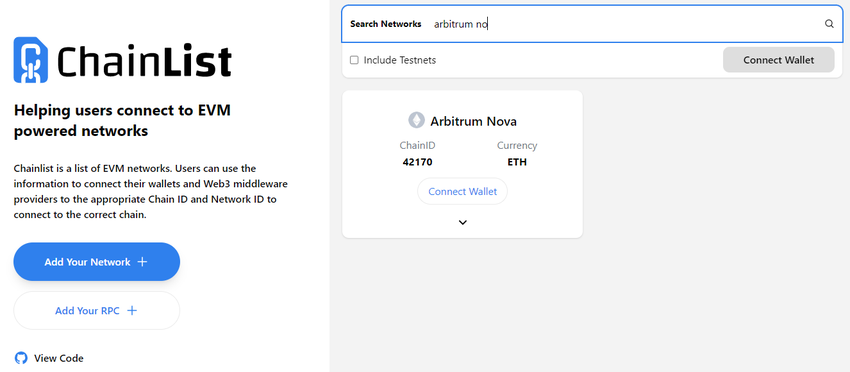
- Next, connect ChainList to MetaMask and then allow it to add Arbitrum Nova to your wallet.
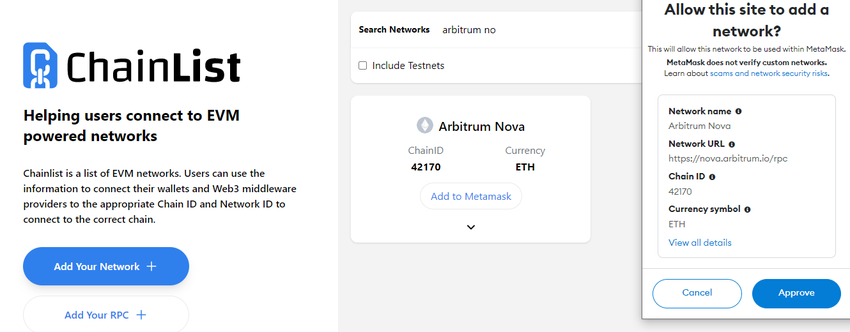
- Switch the network to Arbitrum Nova.

- Alternatively, visit Nova Arbiscan and scroll all the way down to add Arbitrum Nova. At the bottom right side of the website, click “Add Arbitrum Nova Network.”
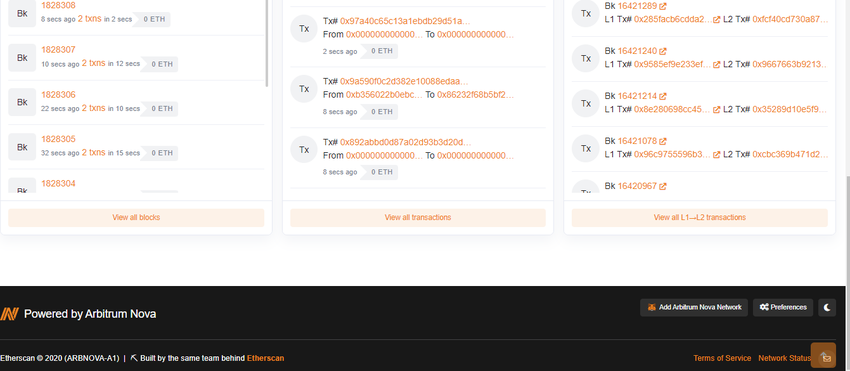
- Next, approve the action.

- Go back to the Arbitrum bridge and click “Go to bridge.”

- Select the token you want to bridge by clicking the drop-down arrow. You can search for crypto by symbol, token/coin name, or L1 or L2 address.
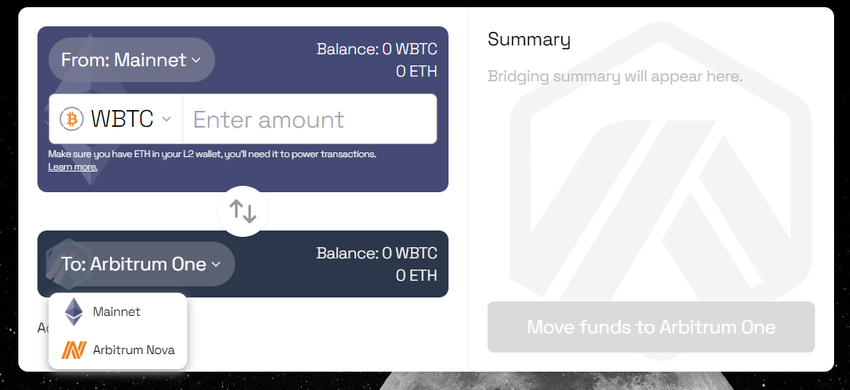
- Next, choose the crypto destination. You have the option to send the coins to Arbitrum One or Arbitrum Nova. You can also go to the advanced settings at the bottom to add the destination address. This step is optional.
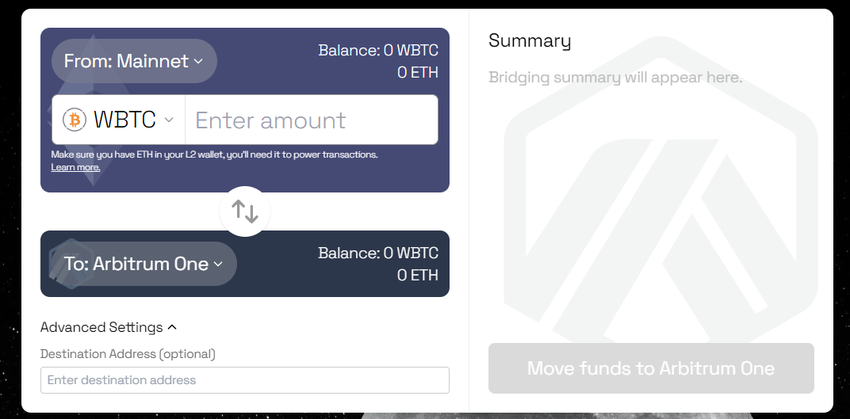
- Click “Move funds to Arbitrum One” to activate the bridging process. Your crypto will arrive in MetaMask in 10 to 60 minutes, depending on network congestion.
Withdraw ETH from Arbitrum to Ethereum
- Confirm that your MetaMask wallet is set to the network you’re withdrawing from. This could be Arbitrum Nova or Arbitrum One. You can change the network on the Arbitrum website without having to open the MetaMask browser extension.

- In the L2 field, select Arbitrum Nova or Arbitrum One.
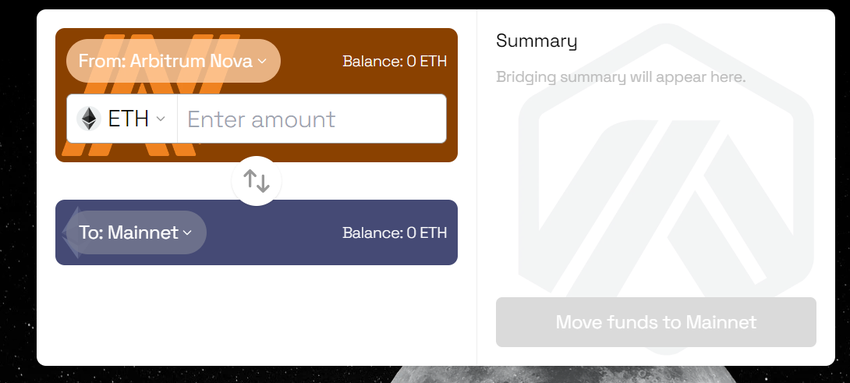
- Choose the crypto you want to bridge.
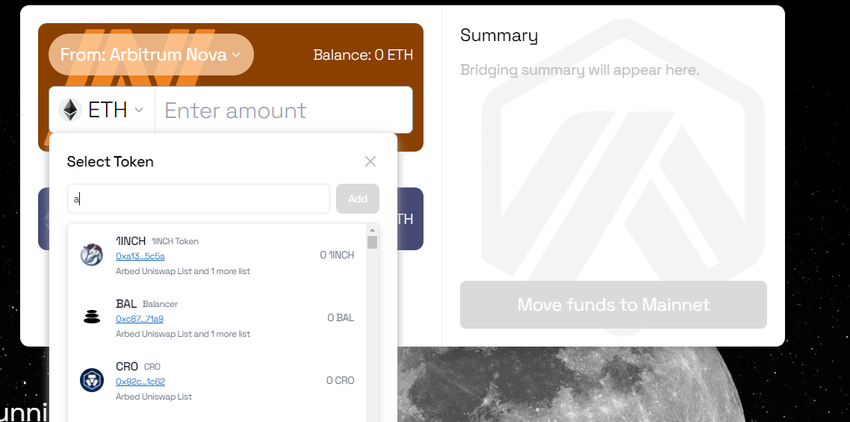
- In the L1 field, select the Ethereum mainnet as the destination.
This bridging process takes longer. The waiting period is at least seven days. The website has a countdown so that you can track how many days are left until you receive your tokens. Once the waiting period is over, switch your MetaMask network to the Ethereum mainnet to view your tokens. If you don’t want to wait this long, you can use a different bridge that’s faster to transfer crypto from Ethereum to Arbitrum. That’s because other cross-chain bridges, such as Connext, Across, and Multichain, also support the transfer of crypto from Ethereum to Arbitrum.
How to use Arbitrum Bridge using WalletConnect
Of course, there are other wallets on the market besides Metamask. Some people that use alternative wallets will require alternative methods to connect to DApps. In this case, you will more than likely have to use WalletConnect. Here, we will use WalletConnect with the ZenGo wallet to show you how to connect to the Arbitrum Bridge.
The ZenGo Wallet is a multi-chain mobile wallet with a light KYC process (just an email address and a quick face scan for verification). They also have an exclusive bonus for BeInCrypto readers: Invite friends to ZenGo using you personal promo code that could be found in Settings in your ZenGo mobile app. Once your friend buy $500 worth of crypto both of you will get a bonus of $10 in BTC.
Here’s how to use Arbiturm Bridge with WalletConnect and ZenGo.
First, download the ZenGo app. It is available on Android and IOS. It requires light KYC — simply an email and a face scan, which should only take a few minutes.
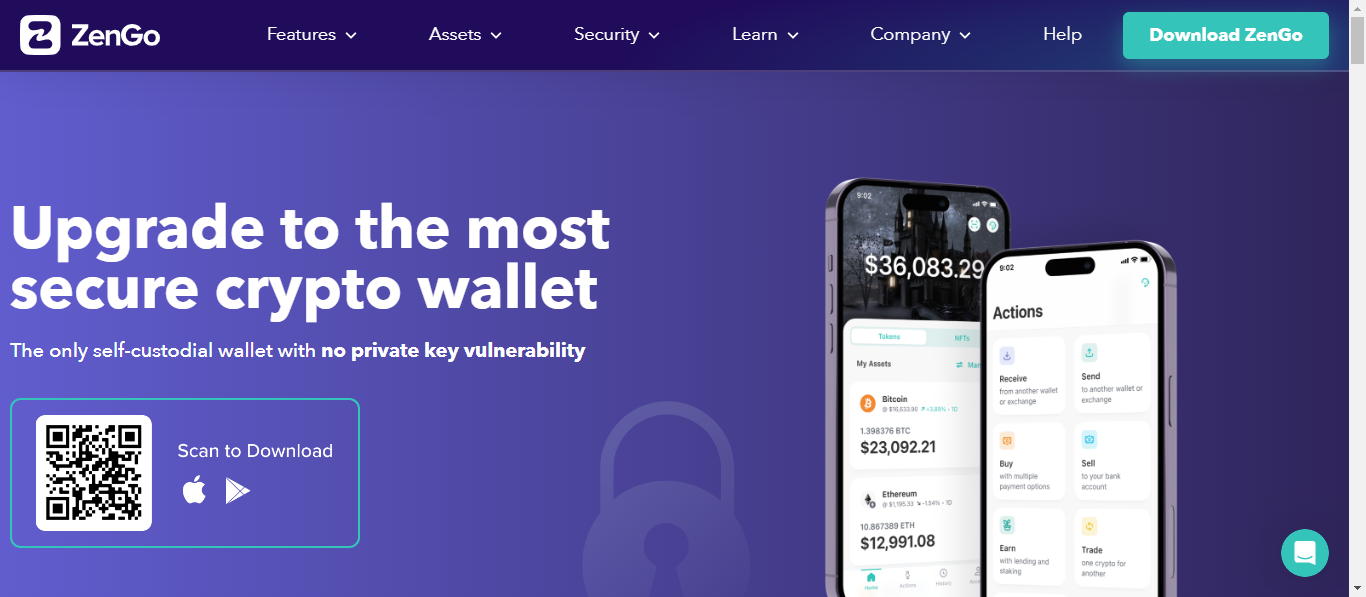
Next, go to Arbitrum Bridge. Select “WalletConnect.”
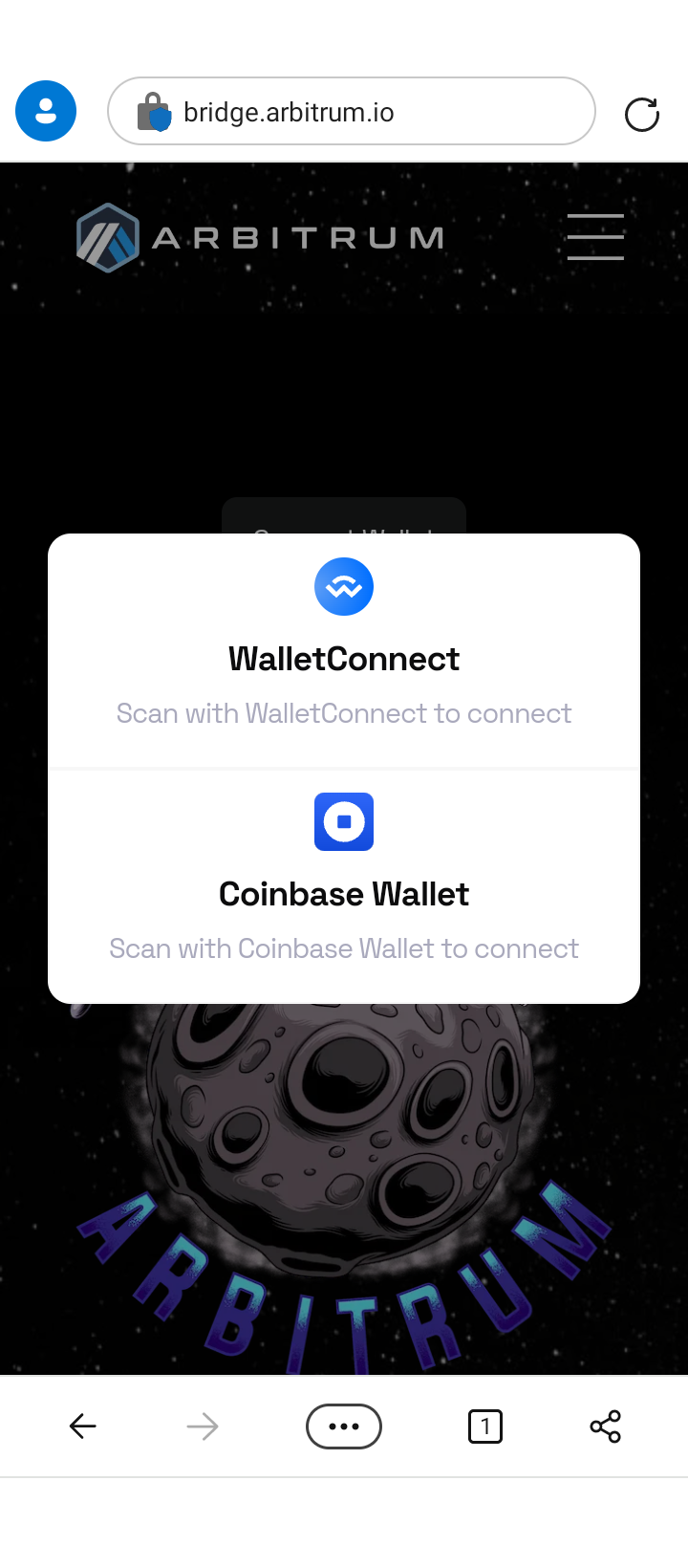
Here you will have multiple choices to connect: “Mobile” or “QR Code.” If you choose “Mobile,” the link will simply direct you to the ZenGo app. If you choose “QR Code,” your next step will be to open the ZenGo app.
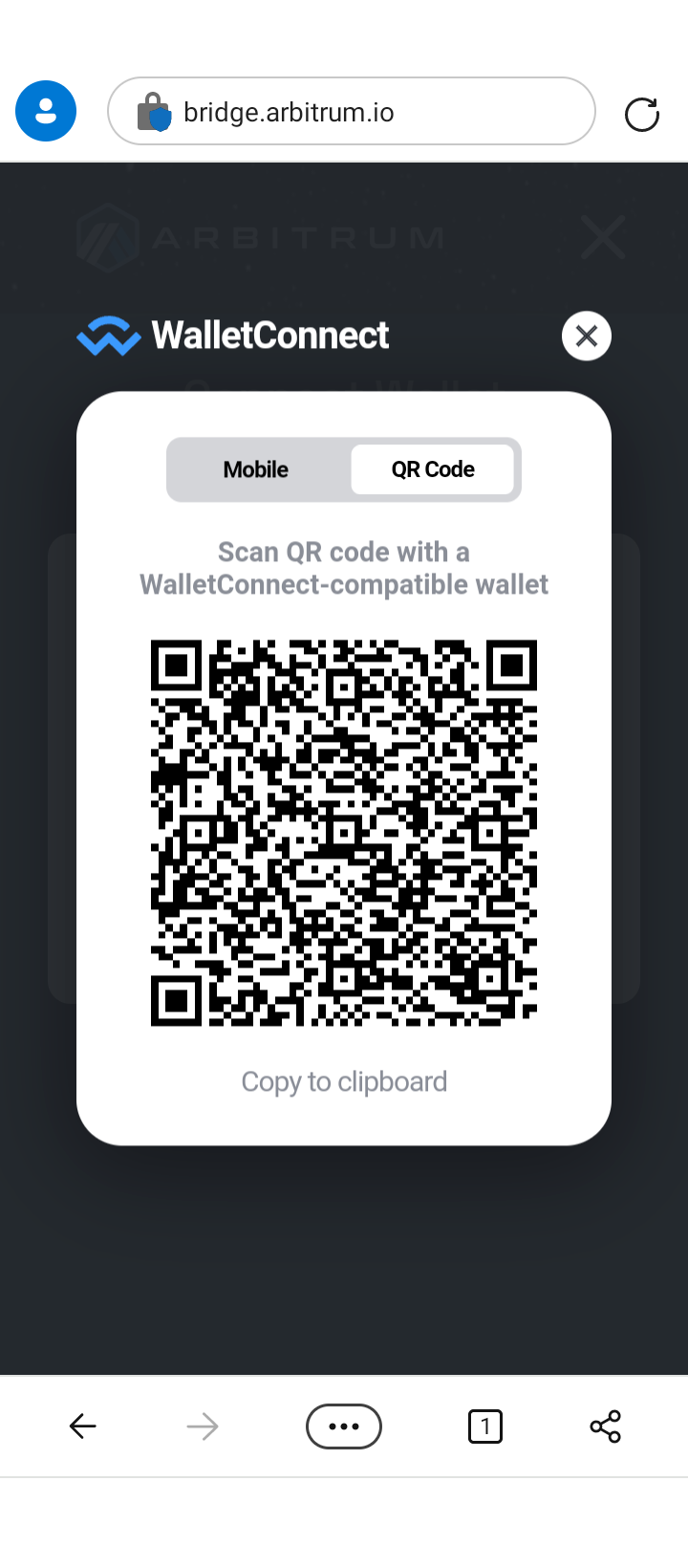
Once you open the ZenGo app, you will notice a button that allows you to connect to DApps.

When you click on the “Connect to apps” button, it will take you to a screen with a QR scanner. You can either use your camera to scan the QR code, or you can paste the QR code directly into the app.

You are now all set to use the Arbitrum bridge.
Using Arbitrum bridge is more simple than it sounds!
Although bridging sounds technical, performing it in real life is actually simple. Always ensure you follow the necessary instructions and confirm that you have selected the correct network before you start bridging. Also, always remember that using bridges risks encountering bugs in smart contracts or losing the value of your coins/tokens due to price volatility.
Since using the Arbitrum bridge is pretty straightforward, you can potentially use it to pay less in transaction fees by moving your Ethereum-based tokens to the Arbitrum chain of your choice. Arbitrum may also offer better transaction speeds than Ethereum. Happy bridging!

